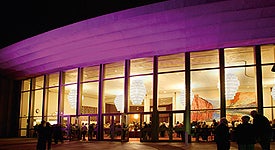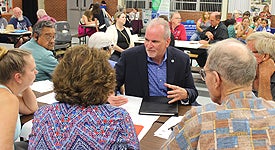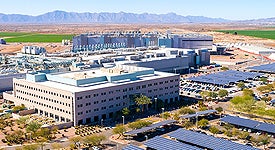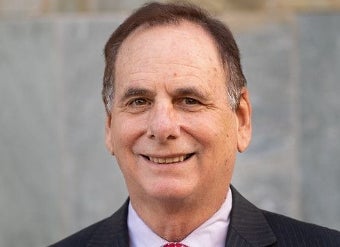This news article first appeared in the SanTan Sun on Feb. 3, 2018.
A number of City projects and programs - old and new - are paying big dividends in terms of safety, cost savings and sustainability.
Last year, Chandler's solid waste recycling program removed 22,183 tons of material from the waste stream. These materials were recycled instead of placed in a landfill. Residents made this happen by using their blue bins and by bringing recyclables to our Recycling-Solid Waste Collection Center.
Chandler was paid $687,657 for the materials. This money helps sustain the program and keep rates low for solid waste services.
Improvements to our street infrastructure are paying off as well. Adding flashing yellow left turn arrows to signalized intersections is improving safety (crashes down 22 percent) and new traffic signal timings rolled out to 60 Chandler intersections hold the promise of improved traffic flow and efficiency.
The City successfully demonstrated that the flashing turn arrow project would improve traffic flow, reducing automobile emissions from traffic congestion. As a result, Chandler received a $633,000 Congestion Mitigation Air Quality grant from the Federal Highway Administration that paid for 83 percent of the project.
The rebuilding of 10 Chandler intersections to include additional through lanes and turn lanes has reduced congestion by a third at these intersections and reduced accidents by an average of 43 percent. As a result of these improvements, an estimated $8.3 million in auto repair costs, lost wages and medical expenses will be saved annually.
Technology is also making a difference on Chandler streets. We are joining cities around the state and country in converting our street lights from High Pressure Sodium (HPS) to Light Emitting Diode (LED) lighting. LED lighting produces more light for less electricity (and less money) than HPS.
The City currently budgets $3.1 million annually to power street lights and traffic signals. Replacing HPS lights with LED has the potential to reduce this outlay by $800,000 a year. There also are savings related to maintenance, as LEDs can last 15-20 years compared to an HPS bulb that may last four or five.
Inroads are being made in areas of sustainability as well. Sustainability has several definitions but is often described as meeting today's needs without sacrificing future generations' ability to meet their needs.
Buildings are a major part of Chandler's sustainability focus, as buildings account for a large portion of our environmental impact. Buildings consume approximately 40 percent of the world's energy and account for more than one-third of the world's greenhouse gas emissions, according to the United States Green Building Council (USGBC).
In 2008, the Chandler City Council adopted a resolution establishing a Green Building Program that provides incentives to encourage the use of sustainable building practices by private sector builders. Additionally, the City resolved to construct "green" City buildings that conform to standards established by the USGBC. These standards, known as Leadership in Energy and Environmental Design (LEED), involve a rating system to evaluate the environmental performance of a building.
Chandler has constructed a number of LEED certified buildings since 2008, including a new fire station, Chandler City Hall and Fire Administration Building. Each of these facilities achieve significant energy savings through improved technology and materials. We've also retrofitted existing City facilities with energy-efficient equipment such as variable fan speed motors on air handlers at the Center for the Arts and more efficient HVAC units in our fire stations, Police Administration building, air traffic control tower and public housing units.
Chandler became the first city in Arizona to recognize solar energy systems in its municipal zoning code when it adopted an ordinance that established separate, more flexible building standards for the installation of residential, commercial and industrial solar systems. And the City has installed solar roof installations at our downtown police facility and the property and maintenance building, plus solar panels on parking structures at our Downtown Library, City Hall, Tumbleweed Recreation Center and Courts facility. Resulting savings in electrical costs are estimated to be $2.3 million over the next 20 years.
Sustainability of our water resources is another area of focus. The City has a comprehensive water management program that emphasizes water conservation and reuse. Through a combination of incentives, low flow plumbing requirements, efficient irrigation systems, low water use landscaping, water conservation ordinances and public education campaigns, residential per capita water demand is on the decline, dropping six gallons per capita per day over the last 10 years and 22 gallons per capita per day since 1996.
Reusing our water is another part of our sustainability push. Wastewater from kitchens, laundry rooms, bathrooms and sinks is collected and transported through a system of underground pipes to water reclamation facilities where it undergoes extensive treatment to meet the state's Reuse and Aquifer Water Quality Standards. The reclaimed water is then used for irrigating turf and low water use landscaping at parks, golf courses, residential common areas, roadside landscaping and non-edible crops. One hundred percent of Chandler's wastewater is reused as a result of this program.
The City of Chandler takes stewardship of taxpayer dollars seriously and strives for efficiency in operations while reducing costs and environmental impacts. Working with the community, we are building a dynamic, sustainable city that values a safe and healthy environment, strong economy and the well-being of every citizen.



